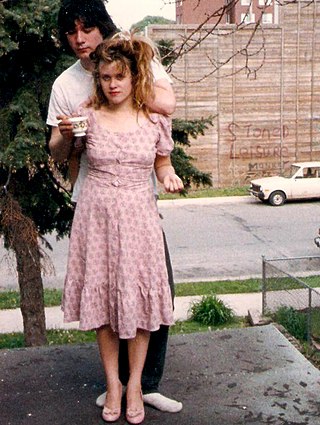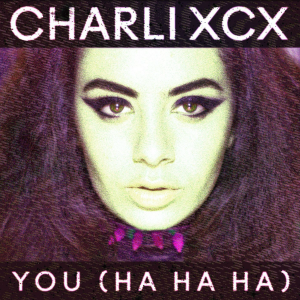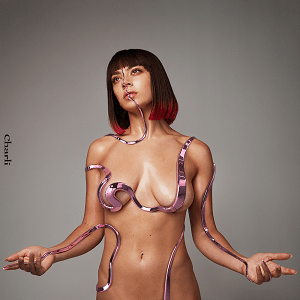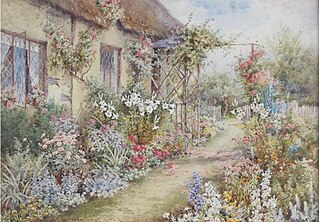
Gothic fashion is a clothing style marked by dark, mysterious, antiquated, homogeneous, and often genderless features. It is worn by members of the goth subculture. Typical gothic fashion includes dyed black hair, exotic hairstyles, dark lipstick and dark clothing. Both male and female goths can wear dark eyeliner, dark nail polish and lipstick for a dramatic effect. Male goths use cosmetics at a higher rate than other men. Styles are often borrowed from the punk fashion and can also draw influence from Victorians and Elizabethan fashion. Goth fashion is sometimes confused with heavy metal fashion and emo fashion.

Kinderwhore is a fashion style most notably worn by some female grunge and alternative rock musicians in the US during the early to mid-1990s. The style is characterized through the combination of cute, feminine fashion items like babydoll and Peter Pan collared dresses, with more adult aspects like smudged red lipstick and dark eye makeup. It has its origins in the mid-1980s band Pagan Babies, which featured future Babes in Toyland vocalist/guitarist Kat Bjelland and future Hole vocalist/guitarist Courtney Love, who lived together and shared clothes. Following the band's disbandment, the two's subsequent bands achieved significant mainstream success and led to the fashion being popularised amongst the general public and being referenced by high fashion designers including Marc Jacobs.

Anti-fashion is an umbrella term for various styles of dress that are explicitly contrary to the fashion of the day. Anti-fashion styles may represent an attitude of indifference or may arise from political or practical goals which make fashion a secondary priority. The term is sometimes even used for styles championed by high-profile designers, when they encourage or create trends that do not follow the mainstream fashion of the time.

Charlotte Emma Aitchison, known professionally as Charli XCX, is an English singer and songwriter. Born in Cambridge and raised in Start Hill, Essex, she began posting songs on Myspace in 2008, which led to her discovery by a promoter who invited her to perform at warehouse raves. In 2010, she signed a recording contract with Asylum Records, releasing a series of singles and mixtapes throughout 2011 and 2012.

Brooke Dyan Candy is an American rapper, singer, songwriter, and tattoo artist. Raised in the suburbs of Los Angeles, she rose to prominence after starring in Grimes' music video for "Genesis" (2012). Following its success, Candy's status in the underground scene rose as she began to release her own music, including the songs "Das Me" (2012), "Everybody Does" (2013), and "I Wanna Fuck Right Now" (2013). In 2014, she signed a recording contract with RCA and released her debut major label single, "Opulence", with an accompanying EP of the same name. Later, she joined Columbia's UK roster.

True Romance is the debut studio album by English singer Charli XCX. It was released on 12 April 2013 by Asylum and Atlantic Records. Originally scheduled for release in April 2012, the album's release was delayed for a full year and had been in the making since early 2010 when Charli met with producer Ariel Rechtshaid in Los Angeles. To promote the album's release, Charli embarked on a three-date UK promotional tour in April 2013.

"You (Ha Ha Ha)" is a song by British singer Charli XCX taken from her major label debut studio album, True Romance (2013). It was released as the album's 4th single in February 2013, along with several remixes. A music video for the song was released on YouTube on 10 January 2013.

"You're the One" is a song by British singer Charli XCX, released as her fifth single on 14 June 2012 exclusively in Australia under Warner Music, and the third single from her debut EP of the same name, and her major-label debut studio album True Romance (2013).

"Boom Clap" is a song by English singer Charli XCX, released as the first single from the soundtrack album of The Fault in Our Stars (2014) and is also featured on her second studio album, Sucker. There are two existing mixes of this song: the first and original one is heard in the film, the film's soundtrack, and the music video shot in Amsterdam; the second mix is heard on the music video shot in Japan and in Sucker.

Alexander Guy Cook is an English music producer and the head of the UK record label PC Music. Cook released his first solo singles in 2014. He has also collaborated with PC Music artists such as Hannah Diamond, GFOTY, EASYFUN, Danny L Harle and felicita. He formed the one-off project QT with musician Sophie and performance artist Hayden Dunham, producing the 2014 single "Hey QT".

Charli is the third studio album by British singer Charli XCX. It was released through Asylum and Atlantic Records UK on 13 September 2019.

Cottagecore is an internet aesthetic idealising rural life. Originally based on a rural European life, it was developed throughout the 2010s and was first named cottagecore on Tumblr in 2018. The aesthetic centres on traditional rural clothing, interior design, and crafts such as drawing, baking, and pottery, and is related to similar aesthetic movements such as grandmacore, goblincore, gnomecore and fairycore.

Dark academia is an internet aesthetic and subculture concerned with higher education, the arts, and literature, or an idealised version thereof. The aesthetic centres on traditional educational clothing, interior design, activities such as writing and poetry, ancient art, and classic literature, as well as classical Greek and Collegiate Gothic architecture. The trend emerged on social media site Tumblr in 2015, before being popularised by adolescents and young adults in the late 2010s and early 2020s, particularly during the COVID-19 pandemic.
Hyperpop is a loosely defined electronic music movement and microgenre that predominantly originated in the United Kingdom during the early 2010s. It is characterised by a maximalist or exaggerated take on popular music, and artists within the microgenre typically integrate pop and avant-garde sensibilities while drawing on elements commonly found in electronic, hip hop, and dance music.

The fashions of the 2020s represent a departure from 2010s fashion and feature a nostalgia for older aesthetics. They have been largely inspired by styles of the early-to-mid-2000s, late 1990s, 1980s, 1970s, and 1960s. Early in the decade, several publications noted the shortened trend and nostalgia cycle in 2020s fashion. Fashion was also shaped by the COVID-19 pandemic, which had a major impact on the fashion industry, and led to shifting retail and consumer trends.

Indie sleaze was a fashion style popular in the United States and United Kingdom from approximately 2006 to 2012. Characterised by an affordable, messy and lethargic take on vintage fashion styles, especially the 1970s, the style was particularly popular amongst the hipster subculture and indie rock bands.
An Internet aesthetic, also simply referred to as an aesthetic or microaesthetic, is a visual art style, sometimes accompanied by a fashion style, subculture, or music genre, that usually originates from the Internet or is popularized on it. Throughout the 2010s and 2020s, online aesthetics gained increasing popularity, specifically on social media platforms such as Tumblr, Pinterest, Instagram and TikTok, and often were used by people to express their individuality and creativity. They can also be used to create a sense of community and belonging among people who share the same interests. The term aesthetic has been described as being "totally divorced from its academic origins", and is commonly used as an adjective.
Throughout its history, the costume of ballet has influenced and been influenced by fashion. Ballet-specific clothing used in productions and during practice, such as ballet flats, ballerina skirt, legwarmers, and leotards have been elements of fashion trends. Ballet costume itself has adapted aesthetically over the years, incorporating contemporary fashion trends while also updating fabrics and materials to allow for greater freedom of movement for the dancers. The classic ballerina costume with a tutu and pointe shoes debuted in the 1830s. Ballet costume is marked by the innovation in lightweight materials such as tulle, chiffon, and organza.
Light academia is an internet aesthetic and subculture, that emphasizes visually light aesthetics and positive themes, including optimism, joy, and friendship. Accordingly, light academia is often considered to be the visually and emotionally lighter counterpart to dark academia. The term light academia was coined on Tumblr in 2019 and gained popularity during the early 2020s.

Coquette aesthetic is a 2020s fashion trend that characterized by a mix of sweet, romantic, and sometimes playful elements and focuses on femininity through the use of clothes with lace, flounces, pastel colors, and bows, often draws inspiration from historical periods like the Victorian era and the 1950s, with a modern twist.



















